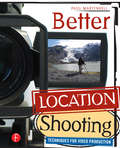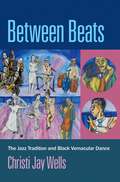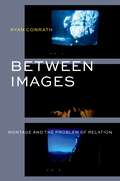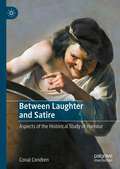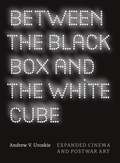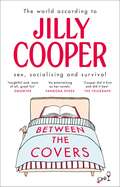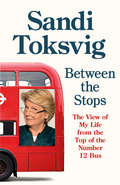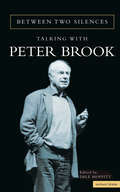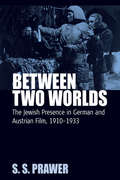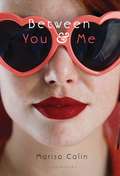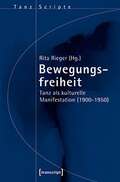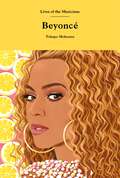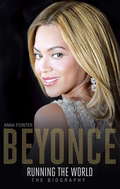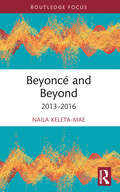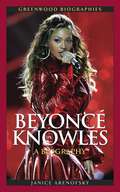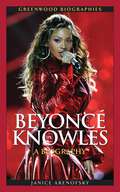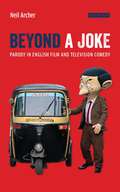- Table View
- List View
Better Location Shooting: Techniques for Video Production
by Paul MartingellLocation filming is growing in popularity with the abundance of affordable cameras. You don't need a studio, a broadcast truck, or even extensive knowledge of how to use a 16mm film camera--all you need is a digital camera, and you can take your job on the road and shoot wherever action is happening! This book will give you the knowledge and confidence you need to take your on-location shooting skills to the next level. Better Location Filming is packed with the things you will need to know to have great results while shooting your documentary, interview, sporting event, fashion or glamour event, or current affairs/news show. Beyond introductory techniques, the author will tell you how to plan, troubleshoot, handle legal requirements and issues, and of course - he'll teach you all about location filming equipment. Practical and filled with hands-on pointers, this book is perfect for working and aspiring film & video professionals seeking a leg up in their careers. As a bonus, advanced tips are included for novices who are ready to take shooting techniques to the next level.
Between Beats: The Jazz Tradition and Black Vernacular Dance
by Christi Jay WellsBetween Beats: The Jazz Tradition and Black Vernacular Dance offers a new look at the complex intersections between jazz music and popular dance over the last hundred-plus years. Author Christi Jay Wells shows how popular entertainment and cultures of social dancing were crucial to jazz music's formation and development even as jazz music came to earn a reputation as a "legitimate" art form better suited for still, seated listening. Through the concept of choreographies of listening, the book explores amateur and professional jazz dancers' relationships with jazz music and musicians as jazz's soundscapes and choreoscapes were forged through close contact and mutual creative exchange. It also unpacks the aesthetic and political negotiations through which jazz music supposedly distanced itself from dancing bodies. Fusing little-discussed material from diverse historical and contemporary sources with the author's own years of experience as a social jazz dancer, it advances participatory dance and embodied practice as central topics of analysis in jazz studies. As it explores the fascinating history of jazz as popular dance music, it exposes how American anxieties about bodies and a broad cultural privileging of the cerebral over the corporeal have shaped efforts to "elevate" expressive forms such as jazz to elite status.
Between Beats: The Jazz Tradition and Black Vernacular Dance
by Christi Jay WellsBetween Beats: The Jazz Tradition and Black Vernacular Dance offers a new look at the complex intersections between jazz music and popular dance over the last hundred-plus years. Author Christi Jay Wells shows how popular entertainment and cultures of social dancing were crucial to jazz music's formation and development even as jazz music came to earn a reputation as a "legitimate" art form better suited for still, seated listening. Through the concept of choreographies of listening, the book explores amateur and professional jazz dancers' relationships with jazz music and musicians as jazz's soundscapes and choreoscapes were forged through close contact and mutual creative exchange. It also unpacks the aesthetic and political negotiations through which jazz music supposedly distanced itself from dancing bodies. Fusing little-discussed material from diverse historical and contemporary sources with the author's own years of experience as a social jazz dancer, it advances participatory dance and embodied practice as central topics of analysis in jazz studies. As it explores the fascinating history of jazz as popular dance music, it exposes how American anxieties about bodies and a broad cultural privileging of the cerebral over the corporeal have shaped efforts to "elevate" expressive forms such as jazz to elite status.
Between Images: Montage and the Problem of Relation
by Ryan ConrathIn the early days of moving pictures, filmmakers learned that the montage could be an effective tool to show changes in time or locale. Casablanca's iconic travel montage is mimicked by filmmakers to this day. Since its use in Rocky, the training montage has become a staple for sports films. In the 2004 film Team America, the song "Montage" is a meta explanation of the device's universal use and understanding. Its history and affects are studied and practiced by student and professional filmmakers alike. "Between Images proposes a unique theory of montage a technique of relation: a way of rethinking and reshaping how humans relateDLto ourselves and each other, to the material world, to the planet and its nonhuman inhabitants. Historically, film criticism has cast editing in one of several roles: as a device of spatiotemporal continuity to maintain the viewer's investment in the story-world; as an agent of disorder that confounds conventions of realism to prompt the viewer's intellectual engagement; and as an expressionistic device for augmenting the duration and combination of shots to leave a sensory impression. While not abandoning such accounts, this book ventures closer to the heart of montage by distinguishing the space between images as itself a powerful source of political, emotional, and aesthetic formation. Venturing into an "expanded field of montage," this study traces the cut and the splice across photographic and cinematic media, where the space between images becomes a setting for navigating and renegotiating the terms of relation, of the "being-with" that connects all forms of life. Between Images brings together a diverse cast of established and emerging film artistsDLHarun Farocki, Hito Steyerl, Steve McQueen, and Cauleen Smith, Da"ichi Saito, and Ja'Tovia Gary among othersDLto demonstrate the abiding capacity of cinema to effect change."
Between Images: Montage and the Problem of Relation
by Ryan ConrathIn the early days of moving pictures, filmmakers learned that the montage could be an effective tool to show changes in time or locale. Casablanca's iconic travel montage is mimicked by filmmakers to this day. Since its use in Rocky, the training montage has become a staple for sports films. In the 2004 film Team America, the song "Montage" is a meta explanation of the device's universal use and understanding. Its history and affects are studied and practiced by student and professional filmmakers alike. "Between Images proposes a unique theory of montage a technique of relation: a way of rethinking and reshaping how humans relateDLto ourselves and each other, to the material world, to the planet and its nonhuman inhabitants. Historically, film criticism has cast editing in one of several roles: as a device of spatiotemporal continuity to maintain the viewer's investment in the story-world; as an agent of disorder that confounds conventions of realism to prompt the viewer's intellectual engagement; and as an expressionistic device for augmenting the duration and combination of shots to leave a sensory impression. While not abandoning such accounts, this book ventures closer to the heart of montage by distinguishing the space between images as itself a powerful source of political, emotional, and aesthetic formation. Venturing into an "expanded field of montage," this study traces the cut and the splice across photographic and cinematic media, where the space between images becomes a setting for navigating and renegotiating the terms of relation, of the "being-with" that connects all forms of life. Between Images brings together a diverse cast of established and emerging film artistsDLHarun Farocki, Hito Steyerl, Steve McQueen, and Cauleen Smith, Da"ichi Saito, and Ja'Tovia Gary among othersDLto demonstrate the abiding capacity of cinema to effect change."
Between Laughter and Satire: Aspects of the Historical Study of Humour
by Conal CondrenThis book explores closely related aspects of the historical study of humour. It challenges much that has been taken for granted in a field of study for which history has been marginal. It disputes the conventional genealogical view that humour theory dates from antiquity and outlines an alternative conceptual history. It critically examines the nostrum that humour is universal. It then explores the methodological difficulties in treating both verbal and non-verbal humour historically, dealing with contextualisation, intentionality, translation and reception. It explores the variable relationships between satire and definition and concludes with a detailed case study from recent history: the iconic Yes Minister and Yes, Prime Minister television comedies. These are commonly seen as realistic, but better understood as presenting popularised theories for satiric and propagandistic effect. Only in their treatment of language can we assess a putative political realism. The satires are often highly perceptive but largely dependent on misleading and inadequate theories of political discourse.Conal Condren is an Emeritus Scientia Professor at UNSW, a member of two Cambridge Colleges and a fellow both of the Australian Academy of the Humanities and The Social Sciences in Australia. He has published widely and principally in early modern intellectual history. Among his books are The Status and Appraisal of Classic Texts; Argument and Authority in Early Modern England; Political Vocabularies: Word Change and the Nature of Politics.
Between the Black Box and the White Cube: Expanded Cinema and Postwar Art
by Andrew V. UroskieToday, the moving image is ubiquitous in global contemporary art. The first book to tell the story of the postwar expanded cinema that inspired this omnipresence, Between the Black Box and the White Cube travels back to the 1950s and 1960s, when the rise of television caused movie theaters to lose their monopoly over the moving image, leading cinema to be installed directly alongside other forms of modern art. Explaining that the postwar expanded cinema was a response to both developments, Andrew V. Uroskie argues that, rather than a formal or technological innovation, the key change for artists involved a displacement of the moving image from the familiarity of the cinematic theater to original spaces and contexts. He shows how newly available, inexpensive film and video technology enabled artists such as Nam June Paik, Robert Whitman, Stan VanDerBeek, Robert Breer, and especially Andy Warhol to become filmmakers. Through their efforts to explore a fresh way of experiencing the moving image, these artists sought to reimagine the nature and possibilities of art in a post-cinematic age and helped to develop a novel space between the “black box” of the movie theater and the “white cube” of the art gallery. Packed with over one hundred illustrations, Between the Black Box and the White Cube is a compelling look at a seminal moment in the cultural life of the moving image and its emergence in contemporary art.
Between the Black Box and the White Cube: Expanded Cinema and Postwar Art
by Andrew V. UroskieToday, the moving image is ubiquitous in global contemporary art. The first book to tell the story of the postwar expanded cinema that inspired this omnipresence, Between the Black Box and the White Cube travels back to the 1950s and 1960s, when the rise of television caused movie theaters to lose their monopoly over the moving image, leading cinema to be installed directly alongside other forms of modern art. Explaining that the postwar expanded cinema was a response to both developments, Andrew V. Uroskie argues that, rather than a formal or technological innovation, the key change for artists involved a displacement of the moving image from the familiarity of the cinematic theater to original spaces and contexts. He shows how newly available, inexpensive film and video technology enabled artists such as Nam June Paik, Robert Whitman, Stan VanDerBeek, Robert Breer, and especially Andy Warhol to become filmmakers. Through their efforts to explore a fresh way of experiencing the moving image, these artists sought to reimagine the nature and possibilities of art in a post-cinematic age and helped to develop a novel space between the “black box” of the movie theater and the “white cube” of the art gallery. Packed with over one hundred illustrations, Between the Black Box and the White Cube is a compelling look at a seminal moment in the cultural life of the moving image and its emergence in contemporary art.
Between the Black Box and the White Cube: Expanded Cinema and Postwar Art
by Andrew V. UroskieToday, the moving image is ubiquitous in global contemporary art. The first book to tell the story of the postwar expanded cinema that inspired this omnipresence, Between the Black Box and the White Cube travels back to the 1950s and 1960s, when the rise of television caused movie theaters to lose their monopoly over the moving image, leading cinema to be installed directly alongside other forms of modern art. Explaining that the postwar expanded cinema was a response to both developments, Andrew V. Uroskie argues that, rather than a formal or technological innovation, the key change for artists involved a displacement of the moving image from the familiarity of the cinematic theater to original spaces and contexts. He shows how newly available, inexpensive film and video technology enabled artists such as Nam June Paik, Robert Whitman, Stan VanDerBeek, Robert Breer, and especially Andy Warhol to become filmmakers. Through their efforts to explore a fresh way of experiencing the moving image, these artists sought to reimagine the nature and possibilities of art in a post-cinematic age and helped to develop a novel space between the “black box” of the movie theater and the “white cube” of the art gallery. Packed with over one hundred illustrations, Between the Black Box and the White Cube is a compelling look at a seminal moment in the cultural life of the moving image and its emergence in contemporary art.
Between the Black Box and the White Cube: Expanded Cinema and Postwar Art
by Andrew V. UroskieToday, the moving image is ubiquitous in global contemporary art. The first book to tell the story of the postwar expanded cinema that inspired this omnipresence, Between the Black Box and the White Cube travels back to the 1950s and 1960s, when the rise of television caused movie theaters to lose their monopoly over the moving image, leading cinema to be installed directly alongside other forms of modern art. Explaining that the postwar expanded cinema was a response to both developments, Andrew V. Uroskie argues that, rather than a formal or technological innovation, the key change for artists involved a displacement of the moving image from the familiarity of the cinematic theater to original spaces and contexts. He shows how newly available, inexpensive film and video technology enabled artists such as Nam June Paik, Robert Whitman, Stan VanDerBeek, Robert Breer, and especially Andy Warhol to become filmmakers. Through their efforts to explore a fresh way of experiencing the moving image, these artists sought to reimagine the nature and possibilities of art in a post-cinematic age and helped to develop a novel space between the “black box” of the movie theater and the “white cube” of the art gallery. Packed with over one hundred illustrations, Between the Black Box and the White Cube is a compelling look at a seminal moment in the cultural life of the moving image and its emergence in contemporary art.
Between the Black Box and the White Cube: Expanded Cinema and Postwar Art
by Andrew V. UroskieToday, the moving image is ubiquitous in global contemporary art. The first book to tell the story of the postwar expanded cinema that inspired this omnipresence, Between the Black Box and the White Cube travels back to the 1950s and 1960s, when the rise of television caused movie theaters to lose their monopoly over the moving image, leading cinema to be installed directly alongside other forms of modern art. Explaining that the postwar expanded cinema was a response to both developments, Andrew V. Uroskie argues that, rather than a formal or technological innovation, the key change for artists involved a displacement of the moving image from the familiarity of the cinematic theater to original spaces and contexts. He shows how newly available, inexpensive film and video technology enabled artists such as Nam June Paik, Robert Whitman, Stan VanDerBeek, Robert Breer, and especially Andy Warhol to become filmmakers. Through their efforts to explore a fresh way of experiencing the moving image, these artists sought to reimagine the nature and possibilities of art in a post-cinematic age and helped to develop a novel space between the “black box” of the movie theater and the “white cube” of the art gallery. Packed with over one hundred illustrations, Between the Black Box and the White Cube is a compelling look at a seminal moment in the cultural life of the moving image and its emergence in contemporary art.
Between the Black Box and the White Cube: Expanded Cinema and Postwar Art
by Andrew V. UroskieToday, the moving image is ubiquitous in global contemporary art. The first book to tell the story of the postwar expanded cinema that inspired this omnipresence, Between the Black Box and the White Cube travels back to the 1950s and 1960s, when the rise of television caused movie theaters to lose their monopoly over the moving image, leading cinema to be installed directly alongside other forms of modern art. Explaining that the postwar expanded cinema was a response to both developments, Andrew V. Uroskie argues that, rather than a formal or technological innovation, the key change for artists involved a displacement of the moving image from the familiarity of the cinematic theater to original spaces and contexts. He shows how newly available, inexpensive film and video technology enabled artists such as Nam June Paik, Robert Whitman, Stan VanDerBeek, Robert Breer, and especially Andy Warhol to become filmmakers. Through their efforts to explore a fresh way of experiencing the moving image, these artists sought to reimagine the nature and possibilities of art in a post-cinematic age and helped to develop a novel space between the “black box” of the movie theater and the “white cube” of the art gallery. Packed with over one hundred illustrations, Between the Black Box and the White Cube is a compelling look at a seminal moment in the cultural life of the moving image and its emergence in contemporary art.
Between the Covers: Jilly Cooper on sex, socialising and survival
by Jilly Cooper OBE'No one else can make me laugh and cry quite like Jilly Cooper.' Gill Sims'Jilly Cooper's non-fiction is just as entertaining as her novels.' Pandora Sykes____________________'One truth I have learnt, as middle age enmeshes me like Virginia creeper, is that I shall never change-because my capacity for self-improvement is absolutely nil.'Jilly Cooper's observations from her days as a much-loved newspaper columnist cover everything to do with sex, socialising and survival - from marriage, friendship and the minutiae of family life, to the tedium of going to visit people for the weekend, the stress of hosting dinner parties and the descent of middle age. Entertaining and full of heart, this classic collection of journalism from the legendary author explores the highs and lows of everyday life with wit, wisdom and warmth.Praise for Jilly Cooper:'Joyful and mischievous' Jojo Moyes'Fun, sexy and unputdownable' Marian Keyes'Flawlessly entertaining' Helen Fielding
Between the Stops: The View of My Life from the Top of the Number 12 Bus
by Sandi ToksvigThis long-awaited memoir from one of Britain's best-loved celebrities - a writer, broadcaster, activist, comic on stage, screen and radio for nearly forty years, presenter of QI and Great British Bake Off star - is an autobiography with a difference: as only Sandi Toksvig can tell it.'Between the Stops is a sort of a memoir, my sort. It's about a bus trip really, because it's my view from the Number 12 bus (mostly top deck, the seat at the front on the right), a double-decker that plies its way from Dulwich, in South East London, where I was living, to where I sometimes work - at the BBC, in the heart of the capital. It's not a sensible way to write a memoir at all, probably, but it's the way things pop into your head as you travel, so it's my way'.From London facts including where to find the blue plaque for Una Marson, 'The first black woman programme maker at the BBC', to discovering the best Spanish coffee under Southwark's railway arches; from a brief history of lady gangsters at Elephant and Castle to memories of climbing Mount Sinai and, at the request of a fellow traveller, reading aloud the Ten Commandments; from the story behind Pissarro's painting of Dulwich Station to performing in Footlights with Emma Thompson; from painful memoires of being sent to Coventry while at a British boarding school to thinking about how Wombells Travelling Circus of 1864 haunts Peckham Rye;from anecdotes about meeting Prince Charles, Monica Lewinsky and Grayson Perry to Bake-Off antics; from stories of a real and lasting friendship with John McCarthy to the importance of family and the daunting navigation of the Zambezi River in her father's canoe, this Sandi Toksvig-style memoir is, as one would expect and hope, packed full of surprises. A funny and moving trip through memories, musings and the many delights on the Number 12 route, Between the Stops is also an inspiration to us all to get off our phones, look up and to talk to each other because as Sandi says: 'some of the greatest trips lie on our own doorstep'.
Between Two Silences: Talking with Peter Brook (Biography and Autobiography)
by Peter BrookThis unusually candid volume of Brook in dialogue provides an uninhibited encounter with contemporary theatre's most influential directorThe result of twelve hours of spontaneous question and answer sessions, Between Two Silences shows Brook responding to points raised by students and lecturers about his work and ideas. Ranging widely over many topics, he talks about his innovative and award-winning production of The Marat/Sade, his film and stage versions of King Lear, and his nine-hour production of the Indian epic The Mahabharata. With passion and clarity he discusses acting, directing, auditions, film versus the stage, his responses to the work of other theatre figures like Grotowski and Artaud, and the multiculturalism which characterises his most recent work. Between Two Silences offers a rare insight into Brook's beliefs and thoughts on theatre, giving straightforward answers to the often complex questions which his work and writings have raised."Brook is someone prepared to dream, take risks, fail and then try again, succeed and still try again: a genius, and a creative one." Benedict Nightingale, (Times Literary Supplement)
Between Two Worlds: The Jewish Presence in German and Austrian Film, 1910-1933 (Film Europa #3)
by S. S. PrawerJews have been well represented in the cinema industry from the beginning of the film era: behind the screen, as producers, distributors, directors, script-writers, composers, set designers; and on the screen, as Jewish actors and as named Jewish characters in the film's plot. Some of these characters are fictional; others, ranging from Rabbi Loew of Prague to Ferdinand Lassalle and Alfred Dreyfus, have a historic original. This book examines how a variety of German and Austrian films treat aspects of Jewish life, at home and in the synagogue, and Jewish interaction with fellow Jews in different cultural environments; conflicts and accommodations between Jews and non-Jews at various times, ranging from the medieval to the contemporary. The author, one of the best known scholars in film history, theory and criticism, offers the reader a rich panorama of the many Jews involved in all spheres of the cinema and who, as the author reminds us repeatedly, together with their non-Jewish contemporaries, created a great industry and new forms of art.
Between You & Me
by Marisa CalinPhyre knows there is something life-changing about her new drama teacher, Mia, from the moment they meet. As Phyre rehearses for the school play, she comes to realize that the unrequited feelings she has for Mia go deeper than she's ever experienced. Especially with a teacher. Or a woman. All the while, Phyre's best friend-addressed throughout the story in the second person, as "you"-stands by, ready to help Phyre make sense of her feelings. But just as Mia doesn't understand what Phyre feels, Phyre can't fathom the depth of her best friend's feelings...until it's almost too late for a happy ending. Characters come to life through the innovative screenplay format of this dazzling debut, and unanswered questions-is "you" male or female?-will have readers talking.
Bewegungsfreiheit: Tanz als kulturelle Manifestation (1900-1950) (TanzScripte #48)
by Rita RiegerUngewöhnliche Bewegungsmuster faszinieren von 1900 bis 1950 sowohl Kunst, Technik und Medizin als auch Alltagskulturen. Die in diesem Band versammelten Einzelanalysen tänzerischer Bewegungen in Ballett, Oper, Musical, Theater, Film und Literatur zeigen die dynamische Verbindung von ästhetischen, medialen und kulturpolitischen Ansprüchen, hinterfragen neben der Tanzästhetik tradierte Konzepte wie Körper, Bewegung, Sprache, Freiheit, Kunst und Kultur und bestimmen diese neu. Die Vielfalt an gleichzeitig in Nord- und Südamerika, Europa und Asien praktizierten Tänzen sowie ihre wandelbaren kulturellen Bedeutungszuschreibungen werden u. a. in Beiträgen von Inge Baxmann, Claudia Jeschke, Rolf Kailuweit, Astrid Poier-Bernhard, Anna Seidl und Frank Reza Links charakterisiert.
Beyoncé (Lives of the Musicians)
by Tshepo MokoenaBeyoncé is not simply a pop sensation. She is a cultural phenomenon empowering the oppressed and dispossessed, challenging white privilege and misogyny and exploding gender politics. But who is Beyoncé Knowles-Carter? And how did a small girl from Houston become the strong confident woman whose albums sell in their millions and whose songs have become anthems against racial and sexual discrimination and oppression? This biography sets out to reveal exactly that.
Beyoncé: The Biography
by Anna Pointer'Everything you ever wanted to know about the world's biggest singing star.' 5* - BestBeyoncé: Running The World is the full story of Houston born-and-bred Beyoncé's extraordinary life, which saw her join her first pop group at the age of nine before fronting the girl band Destiny's Child - the biggest-selling female group of all time. After embarking on a solo career in 2003, Beyoncé's status as a superstar was sealed and to date she has won more than 220 awards internationally and the hearts of millions of fans the world over. The most definitive and up-to-date telling of Beyoncé's story ever written, this book provides an intimate close-up on both her professional and personal life, with the inside story on how she and rapper husband Jay-Z became the biggest power couple on earth. With reports that their marriage was crumbling before the world's eyes on their 2014 joint tour, On The Run, it pieces together the split rumours that plagued them at every turn and documents exactly how they coped with such intense public scrutiny.The book also analyses Beyoncé's role as a mother to young daughter Blue Ivy and explores the hidden heartbreaks of her past, including a tragic miscarriage, a lengthy battle with depression and an agonising rift with her manager father Mathew.While celebrating Beyoncé's greatest triumphs Beyoncé: Running The World uncovers the truth behind the headlines, finding out exactly who 'Queen Bey' is and what really goes on behind the scenes...Contains an extra chapter with the most up-to-date information on the world's biggest star.
Beyoncé and Beyond: 2013–2016 (Routledge Advances in Theatre & Performance Studies)
by Naila Keleta-MaeThis book examines three years of Beyoncé’s career as a pop mega star using critical race, feminist and performance studies methodologies. The book explores how the careful choreography of Beyoncé’s image, voice and public persona, coupled with her intelligent use of audio and visual mediums, makes her one of the most influential entertainers of the 21st century. Keleta-Mae proposes that 2013 to 2016 was a pivotal period in Beyoncé’s career and looks at three artistic projects that she created during that time: her self-titled debut visual album Beyoncé, her video and live performance of "Formation," and her second visual album Lemonade. By examining the progression of Beyoncé’s career during this period, and the impact it had culturally and socially, the author demonstrates how Beyoncé brought 21st century feminism into the mainstream through layered explorations of female blackness. Ideal for scholars and students of performance in the social and political spheres, and of course fans of Beyoncé herself, this book examines the mega superstar’s transition into a creator of art that engages with Black culture and Black life with increased thoughtfulness.
Beyoncé and Beyond: 2013–2016 (Routledge Advances in Theatre & Performance Studies)
by Naila Keleta-MaeThis book examines three years of Beyoncé’s career as a pop mega star using critical race, feminist and performance studies methodologies. The book explores how the careful choreography of Beyoncé’s image, voice and public persona, coupled with her intelligent use of audio and visual mediums, makes her one of the most influential entertainers of the 21st century. Keleta-Mae proposes that 2013 to 2016 was a pivotal period in Beyoncé’s career and looks at three artistic projects that she created during that time: her self-titled debut visual album Beyoncé, her video and live performance of "Formation," and her second visual album Lemonade. By examining the progression of Beyoncé’s career during this period, and the impact it had culturally and socially, the author demonstrates how Beyoncé brought 21st century feminism into the mainstream through layered explorations of female blackness. Ideal for scholars and students of performance in the social and political spheres, and of course fans of Beyoncé herself, this book examines the mega superstar’s transition into a creator of art that engages with Black culture and Black life with increased thoughtfulness.
Beyoncé Knowles: A Biography (Greenwood Biographies)
by Janice ArenofskyAlthough Beyoncé Knowles is not yet 30, the sensual superstar has already succeeded on many levels: as a dancer, singer, composer, model, music producer, video director and actress. Like rap star/entrepreneur Jay-Z, with whom Beyoncé recently married, she has evolved into a businesswoman, who with her designer-mother, Tina Knowles, markets Beyoncé's personal fashion line, House of Dereon. The multi-talented, global entertainer lends her name and image to many commercial and philanthropic ventures. She is the spokeswoman for L'Oreal and appears in ads for Pepsi and Ford.This biography tells the story of a young, talented woman's meteoric rise in the entertainment industry. From a shy, demure Catholic schoolgirl growing up in Houston, Texas, Beyoncé Knowles eventually morphed into the first African-American woman to win the Songwriter of the Year Award from the American Society of Composers, Authors and Publishers Pop Music Awards. The once-shy suburban schoolgirl has gone far beyond her original dream of becoming a first-rate musician and vocalist. With the assistance of her manager-father—former Xerox executive Mathew Knowles—and as lead singer of the R&B girl group Destiny's Child (the world's all-time bestselling female group), Beyoncé has won 10 Grammy Awards and two Golden Globe nominations. Her albums have reached more than 20 million people worldwide, and she has become a cultural icon to music lovers everywhere as well as a role model for young women. Author Janice Arenofsky gives students and general readers alike an insightful look at a music and fashion icon who has a unique niche in popular culture today. Complete with photos, a timeline, and a thorough bibliography.
Beyoncé Knowles: A Biography (Greenwood Biographies)
by Janice ArenofskyAlthough Beyoncé Knowles is not yet 30, the sensual superstar has already succeeded on many levels: as a dancer, singer, composer, model, music producer, video director and actress. Like rap star/entrepreneur Jay-Z, with whom Beyoncé recently married, she has evolved into a businesswoman, who with her designer-mother, Tina Knowles, markets Beyoncé's personal fashion line, House of Dereon. The multi-talented, global entertainer lends her name and image to many commercial and philanthropic ventures. She is the spokeswoman for L'Oreal and appears in ads for Pepsi and Ford.This biography tells the story of a young, talented woman's meteoric rise in the entertainment industry. From a shy, demure Catholic schoolgirl growing up in Houston, Texas, Beyoncé Knowles eventually morphed into the first African-American woman to win the Songwriter of the Year Award from the American Society of Composers, Authors and Publishers Pop Music Awards. The once-shy suburban schoolgirl has gone far beyond her original dream of becoming a first-rate musician and vocalist. With the assistance of her manager-father—former Xerox executive Mathew Knowles—and as lead singer of the R&B girl group Destiny's Child (the world's all-time bestselling female group), Beyoncé has won 10 Grammy Awards and two Golden Globe nominations. Her albums have reached more than 20 million people worldwide, and she has become a cultural icon to music lovers everywhere as well as a role model for young women. Author Janice Arenofsky gives students and general readers alike an insightful look at a music and fashion icon who has a unique niche in popular culture today. Complete with photos, a timeline, and a thorough bibliography.
Beyond a Joke: Parody in English Film and Television Comedy (Cinema and Society)
by Neil ArcherBeyond a Joke explores the myriad ways British film culture has used forms of parody, from the 1960s to the present day. It provides a contextual and textual analysis of a range of works that, while popular, have only rarely been the subject of serious academic attention – from Morecambe and Wise to Shaun of the Dead to the London 2012 Olympics' opening ceremony. Combining the methodologies both of film history and film theory, Beyond a Joke locates parody within specific industrial and cultural moments, while also looking in detail at the aesthetics of parody as a mode. Ultimately, such works are shown to be a form of culturally specific film or televisual product for exporting to the global market, in which 'Britishness', shaped in self-mocking and ironic terms, becomes the selling point. Written in an accessible style and illustrated throughout with a diverse range of examples, Beyond a Joke is the first book to explore parody within a specifically British context and makes an invaluable contribution to the scholarship on both British and global film culture.
